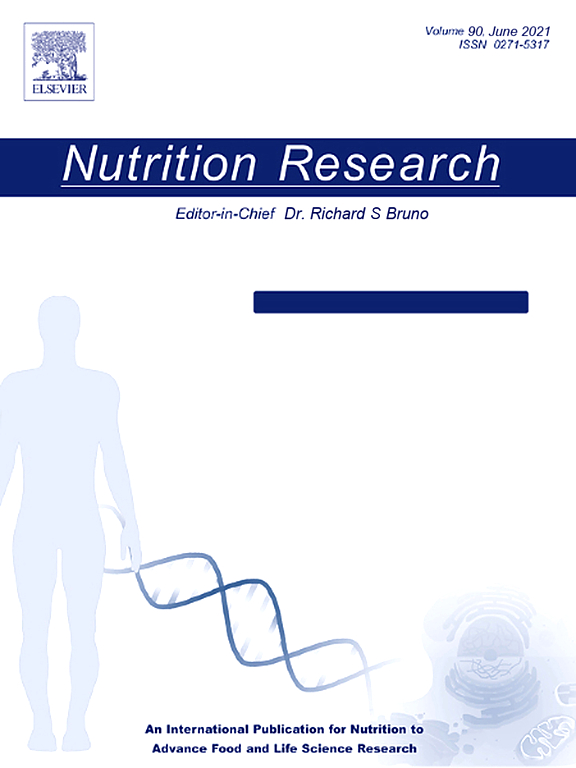Adherence to the EAT-Lancet diet and its association with micronutrient intake in the urban population of eight Latin American countries
IF 3.4
3区 医学
Q2 NUTRITION & DIETETICS
引用次数: 0
Abstract
The EAT-Lancet Commission proposed a dietary framework aimed at reducing the ecological footprint of diets worldwide, but research on adherence to this diet in Latin America is limited. This study aimed to describe the adherence of urban diets in 8 Latin American countries to the EAT-Lancet diet and its association with micronutrient intake inadequacy. This cross-sectional study analyzed baseline data from the Latin American Study of Nutrition and Health, involving 6835 participants from Argentina, Brazil, Chile, Colombia, Costa Rica, Ecuador, Peru, and Venezuela. Data collection included two 24-hour recalls, alongside socio-demographic variables. Usual dietary intake was estimated via the Multiple Source Method and micronutrient inadequacy was evaluated with the Nutrient Adequacy Ratio. The Planetary Health Diet Index (PHDI; ranged between 0 and 150) assessed adherence to the EAT-Lancet diet. Adherence was low (29.7%) across the region, with an average PHDI score of 44.6 ± 9.2 points. Costa Rica had the highest adherence (32.9%), while Argentina had the lowest (25.8%). Older participants, those with overweight/obesity, and with higher socioeconomic status, education, and physical activity had higher adherence. Higher adherence was associated with increased inadequacy risks for cobalamin, vitamin D, and calcium, but decreased risks for pyridoxine, folate, vitamin C, magnesium, and zinc. The study suggests that low adherence may stem from a disconnect between culturally ingrained dietary habits and the EAT-Lancet recommendations, which are primarily informed by nutritional epidemiology and environmental considerations. Recognizing and honoring diverse food cultures is crucial for promoting dietary practices that support human health and environmental sustainability.

坚持EAT-Lancet饮食及其与八个拉丁美洲国家城市人口微量营养素摄入的关系
EAT-Lancet委员会提出了一个饮食框架,旨在减少全球饮食的生态足迹,但在拉丁美洲对这种饮食的依从性的研究有限。本研究旨在描述8个拉丁美洲国家的城市饮食对EAT-Lancet饮食的依从性及其与微量营养素摄入不足的关系。这项横断面研究分析了拉丁美洲营养与健康研究的基线数据,涉及来自阿根廷、巴西、智利、哥伦比亚、哥斯达黎加、厄瓜多尔、秘鲁和委内瑞拉的6835名参与者。数据收集包括两次24小时召回,以及社会人口变量。日常膳食摄入量通过多源法估算,微量营养素不足程度通过营养充足比评估。地球健康饮食指数;范围在0到150之间),评估了饮食-柳叶刀饮食法的依从性。整个地区的依从性较低(29.7%),平均PHDI得分为44.6±9.2分。哥斯达黎加的依从性最高(32.9%),而阿根廷最低(25.8%)。年龄较大的参与者,超重/肥胖的参与者,社会经济地位、教育程度和身体活动水平较高的参与者有更高的依从性。较高的依从性与钴胺素、维生素D和钙不足的风险增加有关,但与吡哆醇、叶酸、维生素C、镁和锌的风险降低有关。该研究表明,低依从性可能源于根深蒂固的文化饮食习惯与EAT-Lancet建议之间的脱节,而EAT-Lancet建议主要是由营养流行病学和环境考虑因素决定的。承认和尊重多样化的饮食文化对于促进有利于人类健康和环境可持续性的饮食习惯至关重要。
本文章由计算机程序翻译,如有差异,请以英文原文为准。
求助全文
约1分钟内获得全文
求助全文
来源期刊

Nutrition Research
医学-营养学
CiteScore
7.60
自引率
2.20%
发文量
107
审稿时长
58 days
期刊介绍:
Nutrition Research publishes original research articles, communications, and reviews on basic and applied nutrition. The mission of Nutrition Research is to serve as the journal for global communication of nutrition and life sciences research on diet and health. The field of nutrition sciences includes, but is not limited to, the study of nutrients during growth, reproduction, aging, health, and disease.
Articles covering basic and applied research on all aspects of nutrition sciences are encouraged, including: nutritional biochemistry and metabolism; metabolomics, nutrient gene interactions; nutrient requirements for health; nutrition and disease; digestion and absorption; nutritional anthropology; epidemiology; the influence of socioeconomic and cultural factors on nutrition of the individual and the community; the impact of nutrient intake on disease response and behavior; the consequences of nutritional deficiency on growth and development, endocrine and nervous systems, and immunity; nutrition and gut microbiota; food intolerance and allergy; nutrient drug interactions; nutrition and aging; nutrition and cancer; obesity; diabetes; and intervention programs.
 求助内容:
求助内容: 应助结果提醒方式:
应助结果提醒方式:


